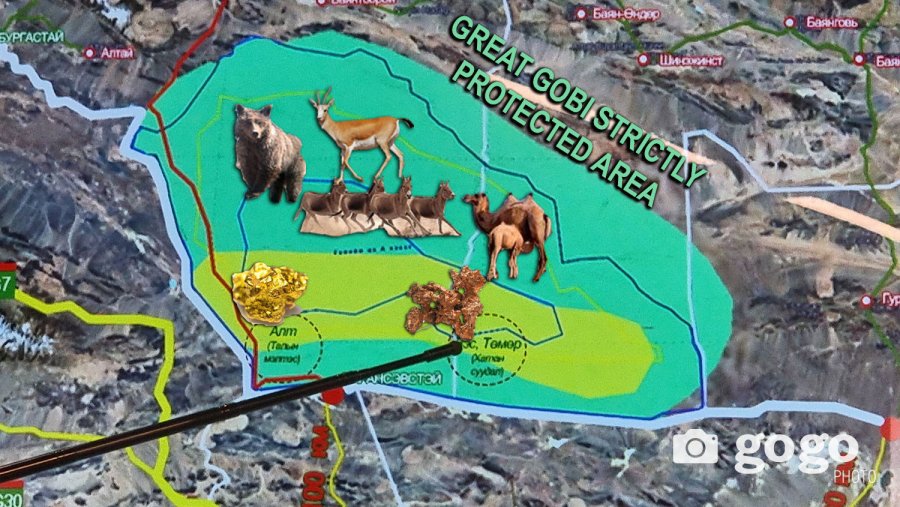November 14, 2024
ULAANBAATAR – Historically, the Great Gobi Strictly Protected Area, located in the Gobi-Altai province, was designated as a national protected area in 1976.
The Gobi ecosystem here is home to an extraordinarily rare diversity of flora and fauna, recognized worldwide. Notably, in 1997, the Great Gobi Strictly Protected Area was listed in UNESCO’s Man and the Biosphere Programme, preserving a desert ecosystem with minimal human impact. It is the habitat for rare animals found only in Mongolia, and some even globally scarce species such as the Gobi bear, wild Bactrian camels, Mongolian wild ass, Przewalski’s horse, black-tailed gazelle, argali, and ibex.
As a result of the protection efforts, the Gobi bear population has risen to around 50, and there are now over 600 wild Bactrian camels. There are 37 species of animals here in critical need of conservation, including argali, ibex, manul, and snow leopards. These species are exceptionally sensitive to disturbances: for example, wild Bactrian camels will detect sound from 10-20 kilometers away and can run continuously for 60-70 kilometers to escape, joining other camel herds along the way. The Gobi bear is also highly cautious and avoids humans and other animals. Thus, opening a border point in this area would disrupt the habitats and migration routes of these sensitive species, experts warn.
The Naransevstein border point was initially opened in the Great Gobi Strictly Protected Area in 1992 but was soon closed due to its negative impacts. The opening drove endangered animals away, degrading their habitats, and illegal activities along the border surged. Yet now…
“THE NARANSEVSTEIN BORDER POINT WILL BE REVIVED”
The government’s 2024-2028 action plan includes a provision to reopen Naransevstein border point.
On August 12, 2024, the government submitted its 2024-2028 program to parliament was approved specifies plans to “Revive and reopen Naransevstein border point”

Experts’ Concerns: In 2008, the “Comprehensive Development Policy of Gobi-Altai Province” proposed exploiting the Taliin Meltes gold deposit with estimated reserves of 200-300 tons as a means to accelerate regional development. While past governments, including those of S. Bayar, N. Altankhuyag, and Ch. Saikhanbileg, tried to include this deposit in economic plans to address national economic difficulties, they met strong opposition. In 2009, environmental advocates and local residents resisted a joint government decision under S. Bayar to remove Khatansuudal (a copper and iron deposit) and Taliin Meltes (a gold deposit) from special protection.

Mongolia currently has 13 border border points spanning 4,709 kilometers, including two in Gobi-Altai: the Burgastai and Shiveekhuren border point. The renewed focus on Naransevstein border point, located in a protected area with vulnerable wildlife, raises questions.
Environmental organizations and experts argue that it is impossible to build a road through the protected area to open this border point. Burgastai border point connects with Altai City through Bugat, Tugrug, and Sharga soums, providing a more direct route to the Chinese border and further to Europe. The insistence on building a road through a delicate ecosystem at Naransuvstain suggests a potential interest in extracting the area’s mineral resources.
The route to Altai City via Burgastai or Shiveekhuren border point is much shorter than via Naransevstein. Advocates of Naransevstein argue it is the only border crossing directly connecting to Gansu Province in China, central China, rather than Xinjiang (Burgastai border point) or Inner Mongolia (Shiveekhuren border point).

Furthermore, former Gobi-Altai governor and parliament member O. Amgalanbaatar states that they plan to build a road corridor to protect wildlife migration. However, experts contend that this corridor would instead restrict the animals’ migration and compress their habitats.
The phrase “Reviving and reopening Naransevstein border point” poses a serious risk to the Great Gobi Strictly Protected Area and its endangered species.
Reopening the border point would contravene the following laws:
Mongolian Constitution:
Article 1.2: “…Democracy, justice, freedom, equality, national unity, and respect for the law shall form the basis of state activity…”
Article 10.2: “…Mongolia shall fulfill its obligations under international treaties…”
Article 70.1: “…Laws, decrees, decisions of state bodies, and activities of citizens must comply with the Constitution…”
International Conventions:
Convention on Biological Diversity, Article 8(d): “…Promote the protection of ecosystems, natural habitats, and the maintenance of viable populations of species in natural surroundings…”

